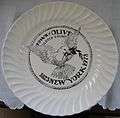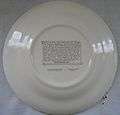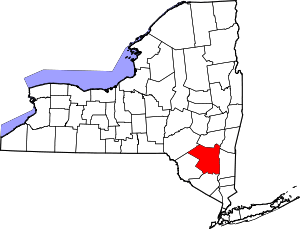Olive, New York
| Olive, New York | |
|---|---|
| Town | |
 Olive, New York Location within the state of New York | |
| Coordinates: 41°57′N 74°15′W / 41.950°N 74.250°WCoordinates: 41°57′N 74°15′W / 41.950°N 74.250°W | |
| Country | United States |
| State | New York |
| County | Ulster |
| Area | |
| • Total | 65.1 sq mi (168.7 km2) |
| • Land | 58.7 sq mi (151.9 km2) |
| • Water | 6.5 sq mi (16.8 km2) |
| Elevation | 705 ft (215 m) |
| Population (2010) | |
| • Total | 4,419 |
| Time zone | Eastern (EST) (UTC-5) |
| • Summer (DST) | EDT (UTC-4) |
| ZIP code | 12461 |
| Area code(s) | 845 |
| FIPS code | 36-54749 |
| GNIS feature ID | 0979307 |
Olive is a town in Ulster County, New York, United States. The population was 4,419 at the 2010 census.
The Town of Olive is an interior town of Ulster County. The town is west of Kingston, New York and is inside the Catskill Park.
History
The town was settled around 1740. The Town of Olive was established in 1823 from parts of the Towns of Hurley, Marbletown, and Shandaken. A limited edition 1973 commemorative plate, shown below, includes this text on the back:
The town of Olive, Ulster County, New York, was taken from Shandaken,Marbletown, and Hurley and erected by law on April 15, 1823. At that time a name was suggested for the new town by quoting the following verse from the Bible: 'and Noah sent out a Dove from the Ark and when the waters subsided she returned with an Olive leaf in her mouth.' 'Let us call it the Town of Olive. 'The first town meeting was held on the second Tuesday in May 1824. the seal was adopted by the Olive Town Board on November 9, 1971. It was suggested by the Town Historian, Vera Sickler, and designed and executed
by Mrs. Tisanne Gardner of Boiceville, N.Y.
| Front (Symbol) | Back (History) |
|---|---|
| |
|
The filling of the Ashokan Reservoir in 1917 covered some of the communities of Olive. The reservoir is owned by New York City and is part of the city's water system.
Olive is also home to one of the most competitive arc pitch softball leagues in all of New York.
Geography
According to the United States Census Bureau, the town has a total area of 65.1 square miles (169 km2), of which, 58.7 square miles (152 km2) of it is land and 6.5 square miles (17 km2) of it (9.93%) is water.
Demographics
| Historical population | |||
|---|---|---|---|
| Census | Pop. | %± | |
| 1830 | 1,636 | — | |
| 1840 | 2,023 | 23.7% | |
| 1850 | 2,710 | 34.0% | |
| 1860 | 3,262 | 20.4% | |
| 1870 | 3,083 | −5.5% | |
| 1880 | 2,927 | −5.1% | |
| 1890 | 2,649 | −9.5% | |
| 1900 | 2,465 | −6.9% | |
| 1910 | 4,497 | 82.4% | |
| 1920 | 1,237 | −72.5% | |
| 1930 | 1,196 | −3.3% | |
| 1940 | 1,320 | 10.4% | |
| 1950 | 1,463 | 10.8% | |
| 1960 | 1,999 | 36.6% | |
| 1970 | 2,857 | 42.9% | |
| 1980 | 3,924 | 37.3% | |
| 1990 | 4,086 | 4.1% | |
| 2000 | 4,579 | 12.1% | |
| 2010 | 4,419 | −3.5% | |
| Est. 2014 | 4,347 | [1] | −1.6% |
As of the census[3] of 2000, there were 4,579 people, 1,869 households, and 1,263 families residing in the town. The population density was 78.0 people per square mile (30.1/km²). There were 2,306 housing units at an average density of 39.3 per square mile (15.2/km²). The racial makeup of the town was 96.68% White, 0.61% African American, 0.17% Native American, 0.92% Asian, 0.17% Pacific Islander, 0.48% from other races, and 0.96% from two or more races. Hispanic or Latino of any race were 2.51% of the population.
There were 1,869 households out of which 29.8% had children under the age of 18 living with them, 55.4% were married couples living together, 7.9% had a female householder with no husband present, and 32.4% were non-families. 24.5% of all households were made up of individuals and 8.5% had someone living alone who was 65 years of age or older. The average household size was 2.43 and the average family size was 2.91.
In the town the population was spread out with 24.2% under the age of 18, 4.6% from 18 to 24, 26.6% from 25 to 44, 31.1% from 45 to 64, and 13.6% who were 65 years of age or older. The median age was 42 years. For every 100 females there were 99.1 males. For every 100 females age 18 and over, there were 96.0 males.
The median income for a household in the town was $45,409, and the median income for a family was $50,931. Males had a median income of $33,125 versus $27,008 for females. The per capita income for the town was $21,569. About 3.5% of families and 5.0% of the population were below the poverty line, including 4.6% of those under age 18 and 3.6% of those age 65 or over.
Communities and locations in Olive, NY
- Ashokan – A hamlet north of the reservoir on Route 28.
- Ashokan Reservoir – The western end of the reservoir is inside the town.
- Beechford – A hamlet at the north town line on Route 28.
- Boiceville – A hamlet at the northwest end of the reservoir on Route 28.
- Brodhead – A hamlet southwest of the reservoir.
- Brodhead's Bridge – A community lost to the Ashokan Reservoir.
- Brown's Station – A community now submerged under the reservoir.
- Cold Brook – A hamlet north of Boiceville on Route 28.
- Davis Corners – A location south of Olivebridge.
- Krumville—A hamlet bordering Samsonville, Olivebridge, and Marbletown.
- Olivebridge – A hamlet south of the reservoir on Route 213.
- Samsonville – A hamlet near the south town line.
- Shokan – A hamlet north of the reservoir on Route 28, west of Ashokan.
- West Shokan – A hamlet at the west end of the reservoir.
- Winchell – A hamlet south of the reservoir and west of Olivebridge.
See also
References
- ↑ "Annual Estimates of the Resident Population for Incorporated Places: April 1, 2010 to July 1, 2014". Retrieved June 4, 2015.
- ↑ "Census of Population and Housing". Census.gov. Retrieved June 4, 2015.
- ↑ "American FactFinder". United States Census Bureau. Retrieved 2008-01-31.
External links
- Town of Olive, NY
- Online Guide to the Catskill Mountains
- The Catskill Archive - history of the Catskill Mtns.
- Olive Free Library
| |||||||||||||||||||||||||||||||||


